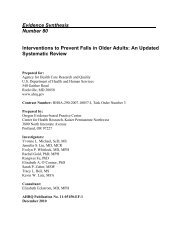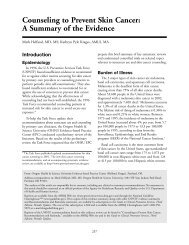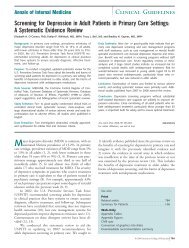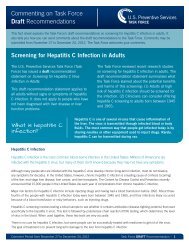Universal Screening for Hearing Loss in Newborns - US Preventive ...
Universal Screening for Hearing Loss in Newborns - US Preventive ...
Universal Screening for Hearing Loss in Newborns - US Preventive ...
You also want an ePaper? Increase the reach of your titles
YUMPU automatically turns print PDFs into web optimized ePapers that Google loves.
TABLE 2Level ofCerta<strong>in</strong>tyHighModerateLow<strong>US</strong>PSTF Levels of Certa<strong>in</strong>ty Regard<strong>in</strong>g Net BenefitDescriptionThe available evidence usually <strong>in</strong>cludes consistent results fromwell-designed, well-conducted studies <strong>in</strong> representativeprimary care populations. These studies assess theeffects of the preventive service on health outcomes.The conclusion, there<strong>for</strong>e, is unlikely to be stronglyaffected by the results of future studies.The available evidence is sufficient to determ<strong>in</strong>e the effects ofthe preventive service on health outcomes, butconfidence <strong>in</strong> the estimate is constra<strong>in</strong>ed by factorssuch as:the number, size, or quality of <strong>in</strong>dividual studies;<strong>in</strong>consistency of f<strong>in</strong>d<strong>in</strong>gs across <strong>in</strong>dividual studies;limited generalizability of f<strong>in</strong>d<strong>in</strong>gs to rout<strong>in</strong>e primary carepractice; orlack of coherence <strong>in</strong> the cha<strong>in</strong> of evidenceAs more <strong>in</strong><strong>for</strong>mation becomes available, the magnitude ordirection of the observed effect could change, and thechange may be large enough to alter the conclusion.The available evidence is <strong>in</strong>sufficient to assess effects onhealth outcomes. Evidence is <strong>in</strong>sufficient because of:the limited number or size of studies;important flaws <strong>in</strong> study design or methods;<strong>in</strong>consistency of f<strong>in</strong>d<strong>in</strong>gs across <strong>in</strong>dividual studies;gaps <strong>in</strong> the cha<strong>in</strong> of evidence;f<strong>in</strong>d<strong>in</strong>gs not generalizable to rout<strong>in</strong>e primary carepractice; ora lack of <strong>in</strong><strong>for</strong>mation on important health outcomesMore <strong>in</strong><strong>for</strong>mation may allow an estimation of effects on healthoutcomes.The <strong>US</strong>PSTF def<strong>in</strong>es certa<strong>in</strong>ty as “likelihood that the <strong>US</strong>PSTF assessment of the net benefit of apreventive service is correct.” The net benefit is def<strong>in</strong>ed as benefit m<strong>in</strong>us harm of the preventiveservice as implemented <strong>in</strong> a general, primary care population. The <strong>US</strong>PSTF assigns a certa<strong>in</strong>tylevel on the basis of the nature of the overall evidence available to assess the net benefit of apreventive service.Assessment of RiskRisk factors associated with a higher <strong>in</strong>cidence of permanentbilateral congenital hear<strong>in</strong>g loss <strong>in</strong>clude NICUadmission <strong>for</strong> 2 days, several congenital syndromes,family history of hereditary childhood sensor<strong>in</strong>euralhear<strong>in</strong>g loss, craniofacial abnormalities, and certa<strong>in</strong> congenital<strong>in</strong>fections. However, 50% of <strong>in</strong>fants with permanentbilateral congenital hear<strong>in</strong>g loss do not have anyknown risk factors.<strong>Screen<strong>in</strong>g</strong> Tests<strong>Screen<strong>in</strong>g</strong> programs should be conducted by us<strong>in</strong>g a 1-or 2-step validated protocol. A frequently used protocolrequires a 2-step screen<strong>in</strong>g process, which <strong>in</strong>cludes otoacousticemissions (OAEs) followed by auditory bra<strong>in</strong>stemresponse (ABR) <strong>in</strong> those who failed the first test.Equipment should be well ma<strong>in</strong>ta<strong>in</strong>ed, staff should bethoroughly tra<strong>in</strong>ed, and quality-control programsshould be <strong>in</strong> place to reduce avoidable false-positive testresults. Programs should develop protocols to ensurethat <strong>in</strong>fants with positive screen<strong>in</strong>g-test results receiveappropriate audiologic evaluation and follow-up afterdischarge. <strong>Newborns</strong> delivered at home, birth<strong>in</strong>g centers,or hospitals without hear<strong>in</strong>g screen<strong>in</strong>g facilitiesshould have some mechanism <strong>for</strong> referral <strong>for</strong> newbornhear<strong>in</strong>g screen<strong>in</strong>g, <strong>in</strong>clud<strong>in</strong>g track<strong>in</strong>g of follow-up.TreatmentEarly <strong>in</strong>tervention services <strong>for</strong> hear<strong>in</strong>g-impaired <strong>in</strong>fantsshould be designed to meet the <strong>in</strong>dividualized needs ofthe <strong>in</strong>fant and family, <strong>in</strong>clud<strong>in</strong>g acquisition of communicationcompetence, social skills, emotional well-be<strong>in</strong>g,and positive self-esteem. Early <strong>in</strong>tervention <strong>in</strong>cludesevaluation <strong>for</strong> amplification or sensory devices, surgicaland medical evaluation, and communication assessmentand therapy. In recent years, cochlear implants havebecome more available <strong>for</strong> appropriate candidates; thissurgery is usually considered <strong>in</strong> those with severe-toprofoundhear<strong>in</strong>g loss only after <strong>in</strong>adequate response tohear<strong>in</strong>g aids.<strong>Screen<strong>in</strong>g</strong> IntervalsAll <strong>in</strong>fants should have hear<strong>in</strong>g screen<strong>in</strong>g be<strong>for</strong>e 1month of age. Those <strong>in</strong>fants who do not pass the newbornscreen<strong>in</strong>g should undergo audiologic and medicalevaluation be<strong>for</strong>e 3 months of age <strong>for</strong> confirmatory test<strong>in</strong>g.Because of the elevated risk of hear<strong>in</strong>g loss <strong>in</strong> <strong>in</strong>fantswith risk <strong>in</strong>dicators, an expert panel has made a 2000recommendation that these children should undergo periodicmonitor<strong>in</strong>g <strong>for</strong> 3 years. 1OTHER CONSIDERATIONSImplementationThirty-n<strong>in</strong>e <strong>US</strong> states have enacted legislation related touniversal newborn hear<strong>in</strong>g screen<strong>in</strong>g (UNHS). Theselaws differ with respect to whether screen<strong>in</strong>g is mandatedor encouraged, how results are reported, and howscreen<strong>in</strong>g is funded.Research Needs/GapsAdditional studies detail<strong>in</strong>g the correlation betweenchildhood language scores and functional outcomes (eg,school atta<strong>in</strong>ment and social function<strong>in</strong>g) are needed.DISC<strong>US</strong>SIONBurden of DiseaseThe focus of UNHS programs is on congenital (as opposedto acquired or progressive) hear<strong>in</strong>g loss that maynot be detected <strong>in</strong> the newborn period. Accord<strong>in</strong>g to the2000 statement from the Jo<strong>in</strong>t Committee on Infant<strong>Hear<strong>in</strong>g</strong> (JCIH), hear<strong>in</strong>g screen<strong>in</strong>g should identify <strong>in</strong>fantsat risk <strong>for</strong> specifically def<strong>in</strong>ed hear<strong>in</strong>g loss that<strong>in</strong>terferes with development. The targeted hear<strong>in</strong>g loss<strong>for</strong> UNHS programs is permanent sensory or conductivehear<strong>in</strong>g loss averag<strong>in</strong>g 30 to 40 dB or more <strong>in</strong> the frequencyregion important <strong>for</strong> speech recognition (500–4000 Hz). 1 PCHL occurs <strong>in</strong> 1 to 3 per 1000 live births.The prevalence <strong>for</strong> PCHL is higher than <strong>for</strong> other conditionsscreened <strong>for</strong> <strong>in</strong> the newborn period. Children withhear<strong>in</strong>g loss may have difficulty learn<strong>in</strong>g grammar, wordorder, idiomatic expressions, and other <strong>for</strong>ms of verbalcommunication. 2 Delayed language and speech, low educationalatta<strong>in</strong>ment, <strong>in</strong>creased behavior problems, de-PEDIATRICS Volume 122, Number 1, July 2008 145









